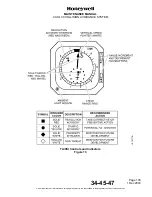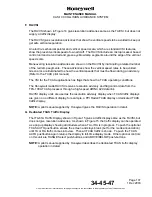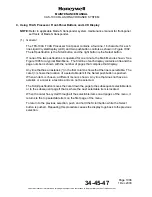
Page 107
1 Dec 2003
34-45-4
7
MAINTENANCE MANUAL
CAS-100 COLLISION AVOIDANCE SYSTEM
Use or disclosure of information on this page is subject to the restrictions in the proprietary notice of this document.
F. RA/VSI
The RA/VSI shown in Figure 14 gives resolution advisories same as the TA/VSI, but does not
supply a traffic display.
The RA/VSI gives resolution advisories that show the vertical speeds to be avoided to keep or
get safe vertical separation.
An electro-mechanical pointer and vertical speed scale, which are standard VSI features,
show the present vertical speed of own aircraft. The RA/VSI includes a microprocessor based
control unit and curved red and green eyebrow lamp segments around the edge of the vertical
speed scale.
Maneuvering resolution advisories are shown on the RA/VSI by illuminating a related number
of the red lamp segments. These advisories show the vertical speed rates to be avoided.
Green arcs are illuminated to show the vertical speeds that must be flown during an advisory.
(Refer to the TCAS pilot manual.)
The VSI for the TCAS applications has flags that show the TCAS operating conditions.
The Honeywell made RA/VSI receives resolution advisory and flag control data from the
TPA-100A TCAS processor through a high-speed ARINC 429 data link.
RA/VSI display units are used as the resolution advisory display when TCAS traffic displays
are given on a different display, for example, a PPI Radar/TCAS display or dedicated TCAS
traffic display.
NOTE:
A
pilot manual supplied by Honeywell gives the RA/VSI operation in detail.
G. Dedicated TCAS Traffic Display
The ITA-81A Traffic Display shown in Figure 15 gives a traffic display same as the TA/VSI, but
does not give resolution advisories. As shown in Figure 15, the traffic display can be operated
as a pop-up display, showing all intruders when a TA or RA is in progress. To push the optional
TCAS AUTO pushbutton erases the screen and stays blank (but for the mode annunciation)
until TA or RA traffic comes into view. Then all TCAS traffic is shown. To push the TCAS
AUTO pushbutton again returns the display to full-time display mode. Other optional controls
on this unit are RANGE Select push-buttons and ABOVE/BELOW push-buttons.
NOTE:
A pilot manual supplied by Honeywell describes the dedicated TCAS traffic
display
operation in detail.
















































